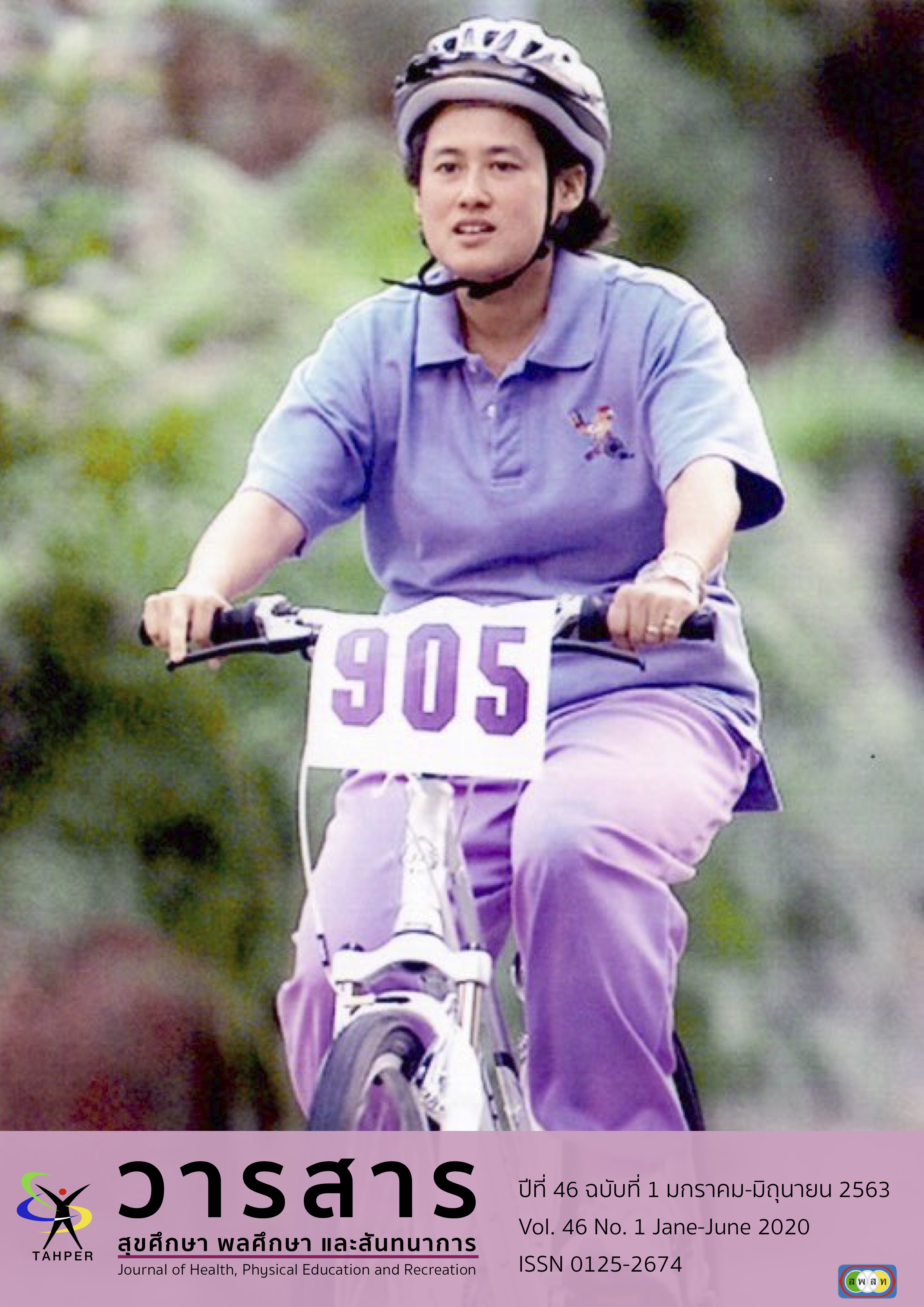Exercise Behaviors and Barriers to Exercise of Kasetsart University Students, Bang Khen Campus
Main Article Content
Abstract
การวิจัยครั้งนี้มีวัตถุประสงค์เพื่อศึกษาพฤติกรรมการออกกำลังกายและอุปสรรคต่อการออกกำลังกายของนิสิตมหาวิทยาลัยเกษตรศาสตร์ วิทยาเขตบางเขน กลุ่มตัวอย่างจำนวน 1,609 คน เครื่องมือที่ใช้ในการวิจัยเป็นแบบสอบถามที่ผู้วิจัยสร้างขึ้น มีความเที่ยงตรงเชิงเนื้อหาโดยผ่านการตรวจสอบของผู้เชี่ยวชาญ จำนวน 3 ท่าน หาค่าดัชนีความสอดคล้อง มีค่า IOC เท่ากับ 0.97 และมีค่าความเชื่อมั่นเท่ากับ 0.80 ทำการเก็บรวบรวมข้อมูลโดยใช้ Google forms วิเคราะห์ข้อมูลด้วยการหาร้อยละ ค่าเฉลี่ย และส่วนเบี่ยงเบนมาตรฐาน
ผลวิจัย พบว่า 1) นิสิตชายและนิสิตหญิงออกกำลังกายเพื่อพัฒนาความอดทนของระบบไหลเวียนเลือดและระบบหายใจด้วยการเดินและจ๊อกกิ้งด้วยความหนักในระดับกลาง สัปดาห์ละ 1-2 วัน โดยแต่ละวันนิสิตชายใช้เวลา 30-60 นาที ส่วนนิสิตหญิงใช้เวลาน้อยกว่า 30 นาที 2) นิสิตชายและนิสิตหญิงจำนวนน้อยกว่า 50% ออกกำลังกายเพื่อพัฒนาความแข็งแรงของกล้ามเนื้อด้วยบาร์เบลและดรัมเบล ส่วนใหญ่ออกกำลังกายสัปดาห์ละ 1-2 วัน เวลาในการออกกำลังกายน้อยกว่า 30 นาทีต่อวัน 3) นิสิตชายและนิสิตหญิงออกกำลังกายเพื่อพัฒนาความอ่อนตัวด้วยการยืดเหยียดกล้ามเนื้อ มีการออกกำลังกายสัปดาห์ละ 1-2 วัน เวลาในการออกกำลังกาย 10-15 นาที
อุปสรรคต่อการออกกำลังกายสำหรับนิสิตชายชั้นปีที่ 1, 2, 3 และ 4 จำนวน 5 ใน 15 ข้อซึ่งอยู่ในระดับกลาง คือ 1) ปัญหาเกี่ยวกับสถานที่ 2) การเดินทางไปสถานที่ออกกำลังกายหรือเล่นกีฬาไม่สะดวก
3) ใช้เวลาในการออกกำลังกายมากเกินไป 4) ไม่มีเวลาในการออกกำลังกายและ 5) ต้องเสียค่าใช้จ่ายในการ
ออกกำลังกายส่วนอุปสรรคต่อการออกกำลังกายของนิสิตหญิงในระดับมาก คือ เรียนมาทั้งวันและรู้สึกเหนื่อยและขี้เกียจมากเกินไป และอุปสรรคในระดับกลาง คือ 1) ปัญหาเกี่ยวกับสถานที่ 2) ใช้เวลาในการออกกำลังกายมาก
The purpose of research was to study exercise behaviors and barrier to exercise of Kasetsart University students, Bang Khen campus. The samples were 1,609 students, 537 males and 1,072 females, were obtained by accidental sampling. The questionnaire consisted of 3 parts: 1) student demographic variables, 2) behavior in exercise, and 3) berries of exercise.
The questionnaire was approved by 3 experts according to the Rovinelli and Hambleton method with IOC of 0.97, and 0.80 for reliability coefficient using Cronbach's alpha. Data were collected by Google forms, and then were analyzed by using percentage, average, and standard deviation.
The findings were as follows: 1) Male and female students exercised to develop cardiorespiratory endurance by walking and jogging with moderate intensity, 1-2 days/week, 30-60 minutes per session for males, and less than 30 minutes per session for females. 2) Less than 50% of male and female students performed exercise to develop muscular strength using barbells and dumbbell, 1-2 days/week, less than 30 minutes a day. 3) Less than 50% of male and female students exercised to develop flexibility using stretching exercise, 1-2 days/week, 10-15 minutes per session.
Perceived barriers to exercise of the 1, 2, 3, and 4 year male students for 5 of 15 items were moderate value: 1) Problems with the location. 2) Getting to the gym or sports facilities was not easy. 3) Take too much exercise. 4) Have no time to exercise, and 5) Have to pay. The barriers in exercise of the 1, 2, 3, and 4 female students at the high level was: Learn all day and feel tired and too lazy. Barriers in the moderate value were: 1) Problems with the location. 2) Too much workout time. 3) Not knowing how to use the exercise equipment, and 4) Getting to the gym or sports facilities was not easy.
Article Details
Critical thinking in journals is the right of the author. The Association of Health Education, Physical Education and Recreation of Thailand is not always required, to create diversity in ideas and creativity.
ความคิด ข้อวิพากษ์ในวารสารเป้นสิทธิของผู้เขียน สมาคมสุขศึกษา พลศึกษา และสันทนาการแห่งประเทศไทยไม่จำเป็นต้องเห็นชอบด้วยเสมอไป เพื่อให้เกิดความหลากหลายในความคิดและความสร้างสรรค์


